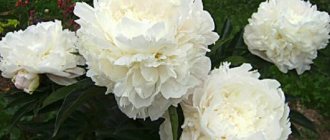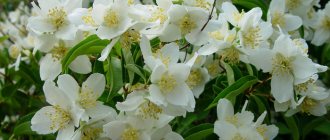What types of peonies are there?
Visual diagram of peony varieties
Peonies are classified according to the structure of the flower:
Terry - Bowl of Cream, Henry Boxtos, Duchess de Nemours, Kansas, Red Spider, Red Charm, Rosella, Sarah Bernard.
Bowl of Cream
Kansas
Red Spider
Red Charm
Rosella
Non-double - Charles Burgess, Neon, Rashumon, Isani Gidui, Waikiki, Cora Stubs, Kukeni Jishi.
Charles Burges
Neon
Waikiki
Cora Stubs
Kukeni Jishi
Semi-double - Miss America, Cytheria, Ann Bury Cousins, Lasters, Sable.
Miss America
Cytheria
Anne Bury Cousins
Sable
Grassy
A perennial that grows wild in the Northern Hemisphere. In Russia you can find 15 species of peony, which live in the Caucasus and the Far East.
The herbaceous peony forms a lush bush, from 50 to 100 cm in height. The stems of the plant die off every autumn to grow again in the spring. Powerful roots accumulate nutrients, which help the plant survive the winter.
- Peony foliage has a complex palmate structure and is light green in color.
- The flowers are large, up to 15 cm in diameter. There are simple, semi-double and double varieties of peony.
- Some varieties are endowed with a rich aroma, and there are varieties that are excellent for cutting.
- The shades of the petals are varied: white, pink, scarlet, burgundy, crimson, two-color.
Popular varieties
Sarah Bernard, the oldest variety with a strong aroma.
Iceberg (USSR) - a snow-white terry variety.
Festava Maxima is a large-flowered, fragrant variety with snow-white flowers interspersed with crimson.
Also: Ama-no-Sodi, Amabilis, Angelo Cobb Freeborn, Ballerina, Baroness Schroeder.
After flowering, large seeds ripen on the stems.
Features of planting and care
The perennial is planted in sunny, wind-protected areas with fertile loamy soil. The location should be chosen carefully, since the peony does not like transplantation and can grow in one place for up to 50 years.
Caring for the plant consists of regular watering and fertilizing during the flowering period, and loosening the soil. Peduncles with heavy buds should be tied to supports so that they do not lean toward the ground. Faded buds are removed so as not to weaken the plant by seed ripening.
For the winter, peony bushes are covered with peat or sawdust to a height of 15 cm.
tree-like
A Chinese species of semi-shrub peony, numbering about 500 varieties. Forms a bush, up to 150 cm high, with large leaves falling off in the winter. The flowers are simple, semi-double or double, very large - up to 25 cm in diameter.
It has all the same shades of petals as the herbaceous one. Tree peony can produce yellow flowers.
In our country, tree peony is not cultivated as widely as herbaceous peony. The reason for this is low winter hardiness and difficulty in care.
However, 17 varieties of tree peonies have been bred in Russia, which feel good even in the conditions of the Urals and Siberia!
Varieties suitable for cultivation
Hoffman is a pink semi-double winter-hardy variety.
Kuindzhi is a yellow non-double variety.
Also: Kiao Sisters, Sapphire, Coral Altar, Green Jade.
Features of planting and care
The perennial is planted in sunny areas, protected from the wind. It is better to do this in the spring so that the plant has time to take root before the onset of cold weather. Peony soil is prepared from a mixture of peat, humus and sand, saturating it with phosphorus-potassium fertilizers. No manure is used!
During the summer season, the plant is regularly watered, the soil is loosened and fed. In autumn, the bushes are mulched with sawdust or fallen leaves, and the crown is wrapped with lutrasil or darnit.
Once every few years, in the spring, the bush is trimmed, removing excess and damaged branches.
Ito peonies
A hybrid obtained by a Japanese florist by crossing a tree and herbaceous peony. The above-ground part of the plant is herbaceous and dies off in winter, saving the gardener from the work of insulating the flower.
The size and color of the flowers are the same as those of the tree-like parent. Thus, the Ito hybrid combines the unpretentiousness of a herbaceous peony and the beauty of a tree peony.
Ito peonies have the same requirements for growing conditions as herbaceous peonies:
- soil – fertile and loose loam;
- a wind-free and sunny place in the flower garden;
- regular watering and fertilizing during the active growing season.
The perennial is planted in the spring, but active foliage growth begins or at the end of summer. The bush is placed in planting holes without deepening the root collar.
Varieties
Barzella (USA) – lemon terry variety.
Dark Eyes (USA) - a simple large flower of a dark purple hue.
Fest Arrival is a soft lilac, non-double flower, 12 cm in diameter.
Features of flowering
Peonies almost always have large flower cups: the average diameter is 14-26 cm. The petals can be either simple, semi-double or double. The last two varieties are especially lush.
Varieties are divided into apical and single. In the first case, one large bud grows surrounded by smaller ones. In the second, only one bud grows on the shoot, but usually it is very large and spectacular.
In the first two years after planting, it is better not to expect active and abundant flowering. Moreover, it is recommended to cut off all the buds that begin to appear in the first two seasons. This measure will help to form a powerful root system of plants, and in subsequent years they will delight with especially long and lush flowering.
In the first year after planting, the plant adapts to the surrounding conditions, adapts, and begins to grow its root system: you understand, flowering in this case will be an unnecessary burden on its “organism.” In the second year, branched, powerful roots continue to form and stems grow: also not yet blooming. In the third year, flowering begins, however, not too abundantly. Peonies will be lushly strewn with buds in a few years.
It will be possible to understand exactly what shade your flowers are only in the fourth or fifth year after planting.
The soil
This plant grows in almost all types of soil, but it will develop differently.
- Leaves develop better on sandy soil than flowers.
- On clay soil you can get larger flowers, but growth will be slower.
The best option is loamy soils, drained, moisture-absorbing and with an acidity of 5.8 to 7.0.
Peonies are frost-resistant plant species.
Good predecessors - the best option would be green manure and black fallow or virgin soil.
Bad predecessors are shrubs, trees and large perennials, which significantly deplete the fertile layer of soil.
Treatment of diseases
Peony diseases
Almost all types of peonies are disease resistant. Exceptions are early flowering terry hybrids. They are often susceptible to diseases, but if you take action, any plant can be cured.
Peonies are usually attacked by various fungi. Sometimes viral diseases can destroy a plant. Great importance must be given to the signs of the disease in order to provide timely treatment:
- Rust. It is urgent to trim off the affected leaves and stems. Treat the bush with a 1% solution of Bordeaux mixture.
- Gray rot. Cut off diseased areas. Spray with a 1% solution of Bordeaux mixture.
- Powdery mildew. Treat the bush with 0.2% Figon solution.
- Mosaic of leaves. Can't be cured. The plant must be destroyed.
- Lemoine's disease. Cannot be treated.
- Verticillium wilt. Can't be cured. The bush should be dug up, destroyed and treated with bleach.
- Leaf spot. Cannot be treated.
Early flowering terry hybrids
How to grow
If peonies are planted in August or early autumn, they are planted directly into the ground. To do this, prepare the planting site by digging and adding mineral fertilizers, adding lime to reduce acidity. Nitrogen, phosphorus and bone meal are best suited.
- Holes 50 cm wide, long and deep are prepared for the bushes. Fertilizers are added to the bottom - humus, superphosphate, ash, phosphorus flour and everything is thoroughly mixed with the soil.
- Water it well with manganese solution, make a small mound, install the bush so that the upper buds go no more than 5 cm into the ground and straighten the roots.
- Cover with soil, water and mulch.
Care consists of regular watering and mandatory loosening of the soil. Weeds should not be allowed to actively grow; they should be removed. When the bushes grow, they are given supports to support large buds. During the growth process, fertilizing is carried out; three are enough - in the spring and two in the summer.
The seedling method is used for planting seeds in winter in order to plant ready-made seedlings in the spring. At the initial stage, the seeds are sown in small containers with sand and placed on a heating pad. During the daytime, the temperature is maintained at about +30ºС, and at night +15ºС. Periodically, the sand is watered with a spray bottle.
After the roots appear, the seedlings are transplanted into a container with fertile soil or peat mixture. The temperature is maintained from +5ºС to +10ºС, and after the leaves appear about +19ºС. It is necessary to ensure regular watering. You can start diving after the first two leaves appear.
Watering the seedlings is done with a solution of mineral fertilizers. After diving, fertilizing is carried out a week later.
Use in garden design
With their lush and bright blooms, peonies attract attention and are a bright accent of the garden composition. Bushes are planted in groups or individually:
- on the lawn;
- form an elongated flower bed along the path;
- planted in the front area, at the entrance to the house.
In mixed flower beds, the peony plays the main role; its neighbors can be plants with decorative foliage, conifers and flowers that bloom after the main soloist of the flowerbed, the peony, has bloomed.
What to plant next to is the best option when there is nothing nearby except grass or lawn. Depending on the color of the flower, you can place nearby - hellebores, barberries, ornamental greens, sage, daylily, poppy, bells, honeysuckle.
More examples of successful peony neighbors: cereals, geranium, white tansy, sedum, iris, delphinium, thuja, juniper.











